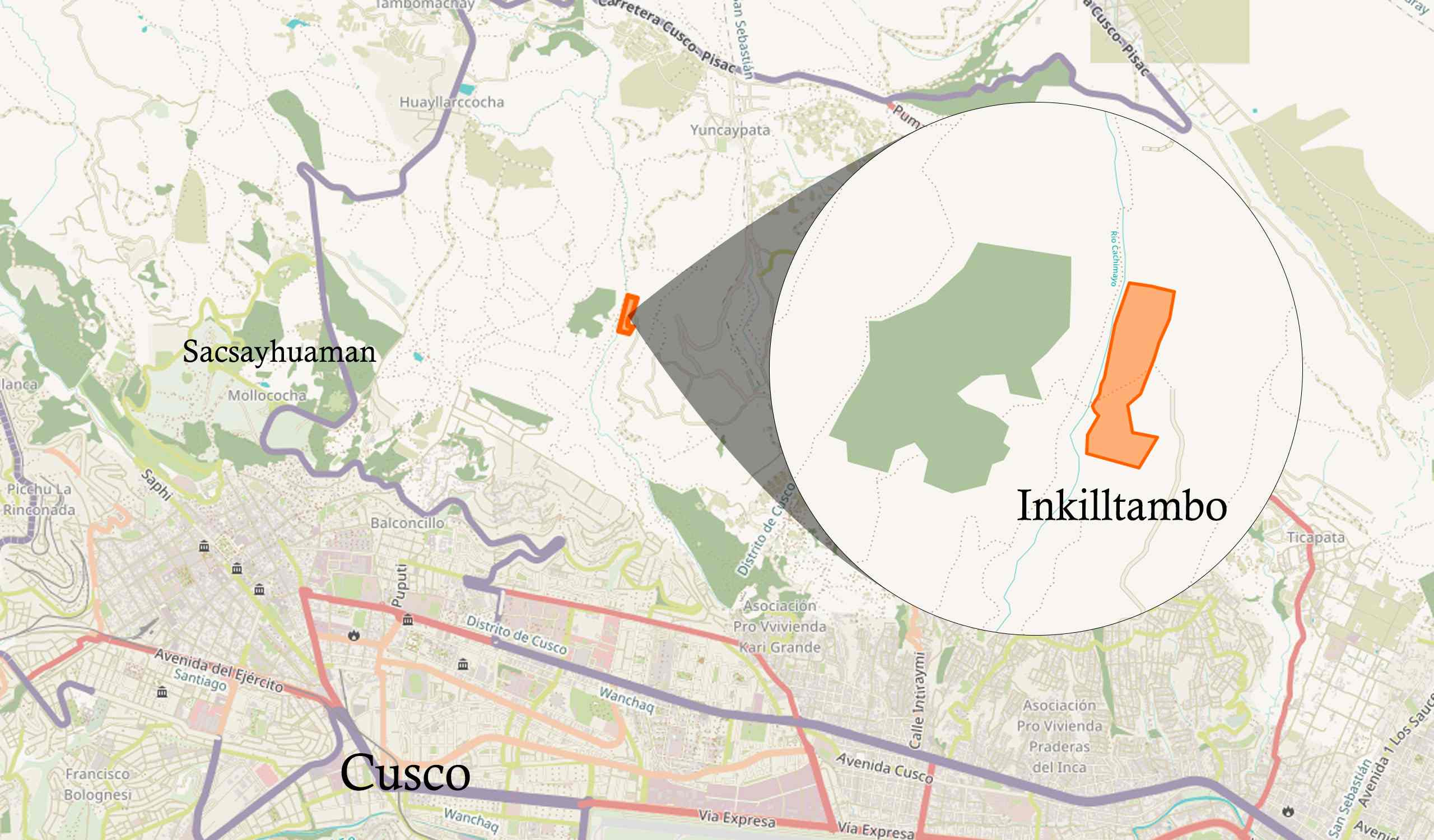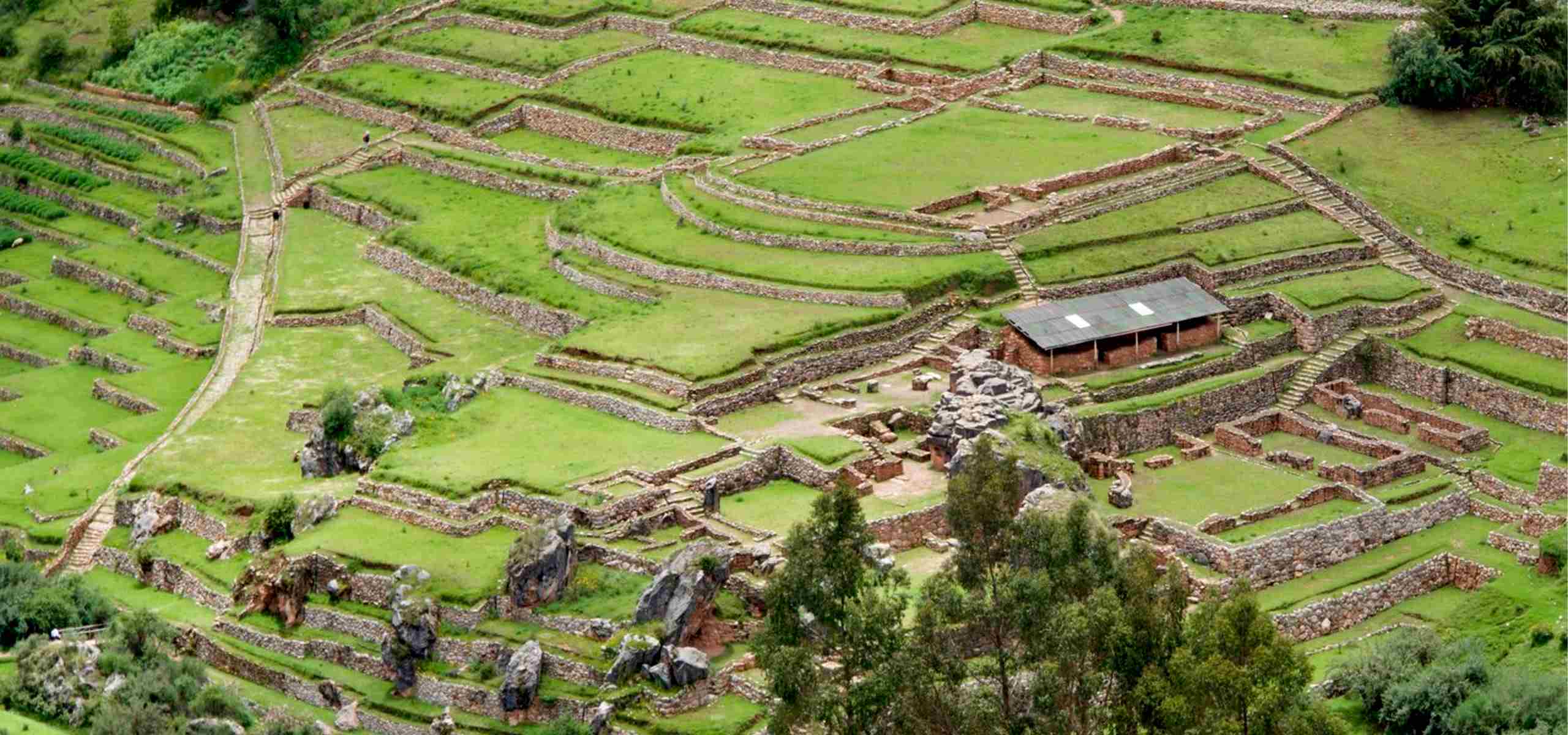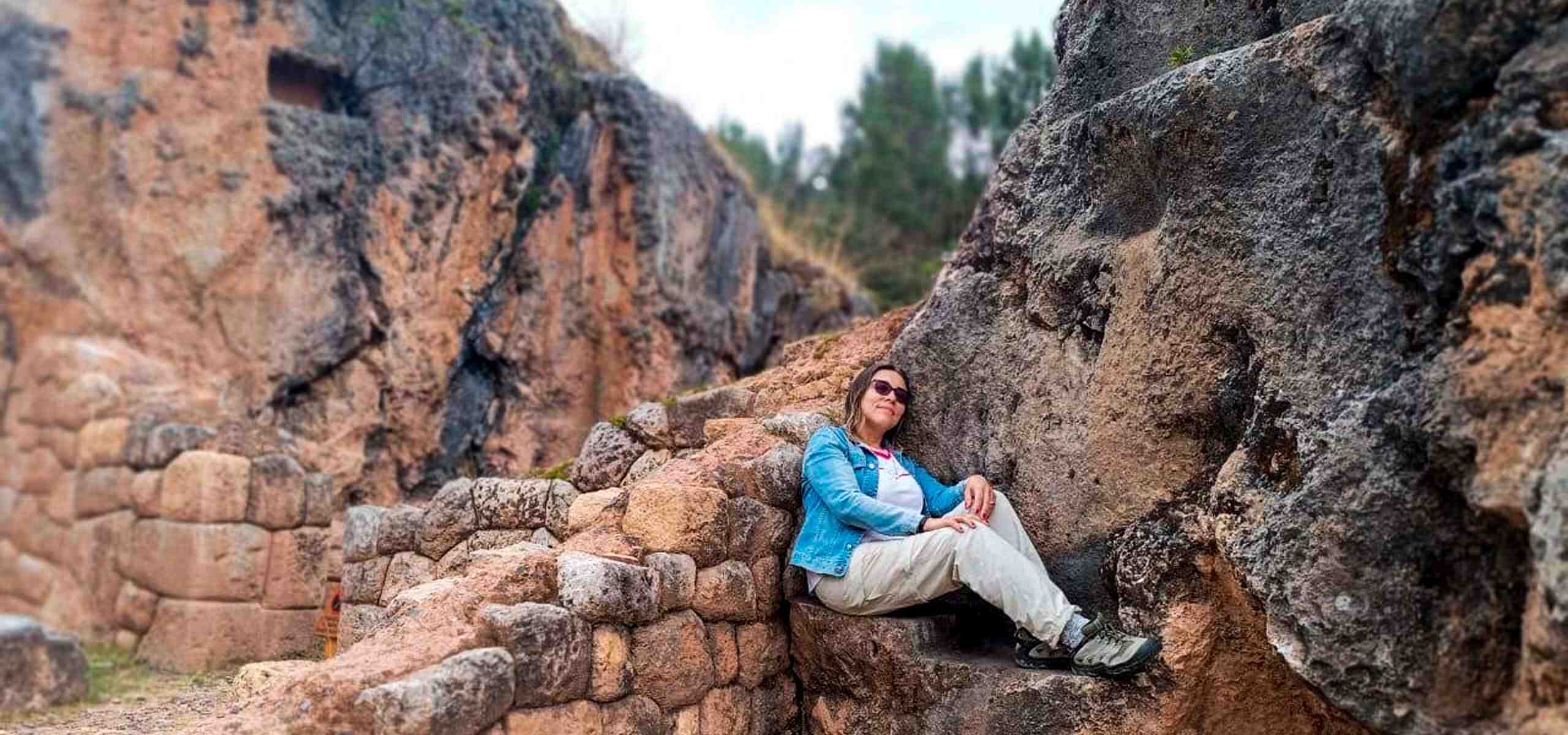The archaeological center of Inkilltambo or Inkacárcel in Cusco was a sanctuary (Huaca in the Quechua language) during the Inca period, has been carved on an immense igneous rock – granite with a total of 5 hornacins (3 outside the immense rock and 2 carved to the al interior), at the top there are several anthropo-morphological figures in high relief and finally the whole shrine is surrounded by andens, aqueducts, drainage systems, etc.
Etymology
The word Inkilltambo comes from two Quechua words: Inkill means garden or flowery place and the word Tambo or Tampu means inn. This toponym literally describes the physical shape of this site.
History of Inkilltambo
Pre-Inca Period
The area's history is deeply rooted in ancient settlements; the Qotakalli, Killke, and Lucre cultures were the early inhabitants responsible for the beginnings of the Inkilltambo archaeological site. This structure was built on natural soils and rocky outcrops, taking advantage of the water that flowed from the upper reaches of Qesallay Punakancha, a site that served as the main source of water supply.
Inca Period
Inkilltambo is considered a product of Inka Wiracocha's reign, with its construction estimated to fall within the years 1420 to 1438 AD. Later, during the reign of Inca Pachacutec and his efforts to reorganize and expand Tahuantinsuyo, a territorial restructuring was carried out based on the division of seques. In this context, Inkilltambo was incorporated as one of the 350 sacred wakas of the empire. This site was considered to hold great religious and spiritual significance, known as the Waka of Susurpuquio del Antisuyo. Rituals related to water worship and canal cleaning were performed there—activities essential for ensuring the success of the agricultural system and, consequently, the economic, social, and cultural stability of the population.
Colonial Era
With the arrival of the Spanish, the evangelization of the Andean populations began. Corregidor Polo de Ondegardo promoted the first colonial ordinances and ordered the construction of five parishes in Cusco. Following that, the people of Susurpuquio (Inkilltambo) were made members of the San Sebastián parish.
Later, the territory was assigned to encomiendas, which led to the destruction of the site by the encomenderos, thus preventing the return of its former inhabitants and causing its abandonment. Over time, the land was distributed among the Spanish, who received it in various forms, such as grants or sales, giving rise to the hacienda system that would mark a new era in the occupation of the valley.
Inkilltambo Today
Between 2015 and 2016, the Ministry of Culture made a million-dollar investment (almost 5 million Soles) to put this archaeological complex in value through the restoration under the charge of archaeologist Marisa Quispe Cuno. During the reclamation period agricultural footpaths, irrigation canals, stone structures, retaining walls, staircases, corridors, Inca paths, etc. were restored.
Today, Inkilltambo is an archaeological site that, although little known and rarely visited by tourists, represents an important historical legacy. Since 2017, it has been the subject of research and restoration efforts and is currently under protection as a reserved area for future study.
Location
This archaeological site is located in the district of San Sebastian (within the archaeological park of Saqsayhuaman).
Architecture
In principle, Inkilltambo was built following the rustic style. However, after the ascension to power of Emperor Pachacutec, a fine style was used that harmonized with the abundant stones of the sector as well as the water sources that exist there.
Its function was that of 'huaca' to worship water. For this purpose, enclosures were built with niches (today there are only five left) and water channels that supplied the terraces supported by enormous stone walls.
Today only the bases of the main buildings remain, as well as the main paths and stone stairs. It is worth noting the neatness of the platforms and the channels that supply them with water.
Inkilltambo also has a finely carved main temple. Food was stored in colcas (warehouses). In the squares (fields) the local settlers met.
Places to visit in this archaeological complex:
- La Huaca (immense rock configurations carved on the same)
- Scores of andenes with agricultural and ceremonial purposes
- Water canals for agricultural irrigation and for consumption
- Trapezoidal horns (there are five in total)
- Tunnels carved in the Huaca
- Inca roads
- Ceremonial squares
- Stairs
- Constructions for storing food or Qolqas in the Quechua language
- Ceremonial courtyards or Kallankas in the Quechua language
- Indigenous communities that currently still live in the vicinity of this place
- Crystalline river of Inkilltambo
How to get to Inkilltambo?
To visit the Inkilltambo archaeological site, there are several routes—ideal both for those seeking a leisurely hike and for those looking for a more immersive experience exploring the surroundings of Cusco.
- Route 1: By Public Transportation (cheap and direct)
Go to the bus stop located on Recoleta Avenue, just above or behind the Rosaspata market. There, you’ll find the Inka Express buses (green buses), which will take you to a stop known as “Tienda” for just 1 sol. The journey takes approximately 15 minutes.
Once at the bus stop, you’ll need to walk a few minutes to the entrance gate of the archaeological site, where you'll be asked to show your ID or passport. From there, a beautiful, clearly signposted hike begins. As you continue, the trail forks—choose the path that goes uphill. The entire walk from the entrance to Inkilltambo takes about an hour, especially if you're traveling with your family or stopping to enjoy the scenery. - Route 2: By Taxi (more comfortable and faster)
You can also choose to take a taxi from downtown Cusco to the “Tienda” bus stop for approximately 15 to 20 soles. This option is more convenient and direct, ideal if you prefer to avoid the hassle of public transportation. - Additional Option: Hike from Inkilltambo to Sacsayhuamán
If you want to extend your adventure, you can continue your hike from Inkilltambo to Sacsayhuaman (or vice versa). This route allows you to visit other important archaeological sites, such as the Temple of the Moon and Qenqo, making your trip a much more enriching and complete experience.
How much does it cost to go on your own?
Admission to Inkilltambo is completely free for everyone, whether they are national or foreign tourists.
The only expense (optional) to go on your own is transportation. The public transport buses to the sector of the Temple of the Moon or the southern zone of Sacsayhuaman have a cost of 1 Peruvian sol (0.3 dollars, approximately).
Are there tours?
Tours to Inkilltambo are not very popular among tourists visiting Cusco.
Very few tourism agencies offer this type of service. One of the few tours offers a bike tour through Inkilltambo. Prices vary from 15 to 30 dollars per person (ask directly to the tourism agency of your choice).
What Is the Best Time to Visit Inkilltambo?
If you're thinking of visiting Inkilltambo, the best time to go is between May and September, when the weather is more stable and rainfall is scarce or nonexistent. This dry season offers clear skies, more accessible trails, and a more comfortable hiking experience. It's ideal for enjoying the natural surroundings, taking photographs, and exploring without setbacks.
Inkilltambo Weather
Located in the Cusco region, Inkilltambo has a sub-humid, cold mountain climate, typical of the Andes. The average annual temperature is 15.7°C, although it varies considerably between day and night. During the day, temperatures can reach up to 16.6°C, with clear skies and a radiant Andean blue that enhances the landscape. At night, the cold intensifies, with temperatures dropping as low as 0°C, so it is recommended to bring a coat if you plan to be outside after dark.
Seasons of the Year
- Rainy Season: From November to mid-April. Trails can become slippery, and some routes may be temporarily closed. Although the landscape is greener, it is less suitable for long hikes.
- Dry Season: From May to late August. This is the most recommended time to explore Inkilltambo. The weather conditions are ideal for safe exploration and enjoying the beautiful surroundings without interruption from bad weather.
When to visit this place?
You can do it preferably in dry season, that is from April to December; the rest of the months it rains quite a bit.
Are there restaurants in this place?
Well, we comment to you that yes, at the top of this archaeological complex there is a traditional food restaurant; however, they may not cater some days, so we recommend you always bring a snack or snacks.
What is the route to Inkilltambo?
If you go on foot by public transport, the walk is very smooth, the route is safe, signposted and super preserved.
Recommended for:
- People who like to visit archaeological sites crowded with tourists
- People looking for free places to visit
- Families who wish to spend pleasant moments in the countryside
- People who like to walk or bike
What to take?
- Good shoes (non-slip)
- Snacks or snacks
- Water
- Waterproof
- Gorras
- Glasses for sunglasses
- Sun blockers
Tip: You can also bring your pet, we saw that there are no restrictions for four-legged friends; this fact is very important because if you visit other archaeological sites such as Sacsayhuaman, Qenqo, Tambomachay, etc You will not be allowed to access the place with your pet.
Other nearby tourist attractions
During your visit to Inkilltambo you can also get to know the following tourist attractions in Cusco:
- The Temple of the Moon – Set of stones where a mysterious cavern stands out which, according to the belief of the inhabitants, symbolized fertility. Admission to this place is free. It is located just 2 kilometers on foot from Inkilltambo, approximately.
- The Kallachaka – This Inca construction has a circular pyramid shape where religious ceremonies were held. The area has Inca trails, sets of platforms, stone banks and beautiful landscapes. Admission is free. It is located about 5 kilometers on foot from Inkilltambo, approximately.
- Qenqo – This archaeological site has mysterious constructions such as tunnels, an amphitheater, a small Intihuatana (sundial) and an underground room with a ceremonial table where sacrifices were probably made. It is 5 kilometers (on foot) from Inkilltambo, approximately. The entrance ticket is the Cusco Tourist Ticket that costs 70 Peruvian soles and includes Sacsayhuaman, Pucapucara and Tambomachay.
- Sacsayhuaman – The famous archaeological site of Sacsayhuaman stands out for its immense walls with stones weighing more than 120 tons. It was a religious center that served as a fortress during the wars between the Incas and the Spanish in the 16th century. It is located 5 kilometers walk from Inkilltambo. The entrance is with the Tourist Ticket of Cusco.
Best Tours in Peru
Many are the routes that take you to Machu Picchu, but none is like the Inca Trail Tours, the most famous pedestrian path in the Americas. After flying from the capital of Perú, Lima, you will arrive in Cusco to walk for four days along a path through forests and dense fog, millenary stone steps and discovering the ruins of ancient fortifications and Inca cities, and all the time enjoying majestic views.
- Salcantay Trek Peru to Machu Picchu 5 days
- Palcoyo Mountain Tour
- Cusco to Manu Tour
- Humantay Lake Day Trip
- Huchuy Qosqo Day Hike
- Half Day Cusco City Tour
- Llactapata Inca Trail to Machu Picchu
- Qoyllur Riti Festival
- Apurimac River Rafting
- Vilcabamba Trek to Machu Picchu
- Inti Raymi and Machu Picchu Tour
- Salkantay Inca Trail Combo
- Waqrapukara Peru Full Day Tour
- Sacred Valley Bike Tour
- Honeymoon in Machu Picchu
- 1 Day Inca Trail Hike to Machu Picchu
- Sacred Valley Tours
- Lares Trek to Machu Picchu 4 Days
- Huchuy Qosqo Trek to Machu Picchu
- Short 2 Day Inca Trail Hike to Machu Picchu
- 2 Day Inca Trail with Camping
- 7 Lakes Ausangate Trek
- 4 Day Jungle Trek to Machu Picchu
- Inca Quarry Trail to Machu Picchu
- Urubamba River Rafting
- 5 Days Salkantay Mountain Trek
- 3 Days Salkantay Trek to Machu Picchu
- Huchuy Qosqo Trek to Machu Picchu
- 7 Lakes Ausangate Trek
If you want to visit Machu Picchu, we recommend you to book your Machu Picchu Ticket in advance, so you will enjoy your Vacation in Machu Picchu without any problem.









